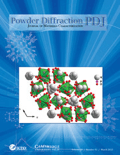
POWDER DIFFRACTION
Scope & Guideline
Exploring Crystalline Insights through Innovative Techniques
Introduction
Aims and Scopes
- Crystallographic Structure Determination:
The journal publishes articles detailing the crystal structures of a wide range of compounds, including organic, inorganic, and pharmaceutical substances, emphasizing the importance of accurate structural elucidation in materials science. - Powder Diffraction Techniques:
A core focus is on advancements in powder diffraction methodologies, including X-ray and neutron diffraction, which are essential for analyzing polycrystalline materials. - Applications in Material Science:
Research often explores the application of powder diffraction in diverse fields such as materials science, geology, chemistry, and pharmaceuticals, highlighting its role in understanding material properties. - Data Processing and Analysis:
The journal emphasizes innovative approaches to data processing and analysis, including quantitative phase analysis and Rietveld refinement, which are crucial for deriving meaningful information from diffraction data. - Interdisciplinary Collaboration:
It also promotes interdisciplinary research that integrates crystallography with computational methods, environmental science, and other fields, reflecting the diverse applications of powder diffraction.
Trending and Emerging
- Pharmaceutical Applications:
There is a growing emphasis on the crystal structures and powder diffraction data of pharmaceutical compounds, highlighting the journal's relevance in drug development and formulation analysis. - Advanced Data Processing Techniques:
Recent issues reveal an increasing interest in sophisticated data processing methods, such as machine learning and advanced statistical techniques, to enhance the accuracy and reliability of diffraction data interpretation. - Sustainability and Environmental Research:
Emerging themes include the characterization of materials related to sustainability, such as CO2 capture materials, indicating a shift towards addressing global challenges through material science. - Nanomaterials and Thin Films:
Research focusing on nanomaterials and thin films is on the rise, reflecting the growing interest in the properties and applications of materials at the nanoscale, particularly in electronics and energy storage. - In situ and Operando Studies:
There is an increasing trend towards in situ and operando studies that allow researchers to observe structural changes in materials under real-time conditions, providing deeper insights into material behavior.
Declining or Waning
- Historical Crystallography:
Papers focusing on historical aspects or ancient materials, such as the investigation of ancient bronze drums, appear to be less frequent, indicating a waning interest in historical crystallography compared to modern applications. - Basic Crystal Chemistry:
There seems to be a decline in publications centered solely on basic crystal chemistry without practical applications, as the journal increasingly favors studies that connect crystal structures to practical material applications. - Traditional Materials Analysis:
Research on conventional materials analysis techniques that do not incorporate advanced methodologies or interdisciplinary approaches is becoming less common, with a trend towards more innovative and integrated research.
Similar Journals
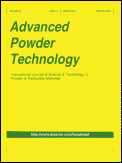
ADVANCED POWDER TECHNOLOGY
Leading the Charge in Advanced Powder ApplicationsADVANCED POWDER TECHNOLOGY, published by Elsevier, is a premier academic journal dedicated to advancing the field of powder technology and its applications across various domains, such as chemical engineering and materials science. With an ISSN of 0921-8831 and an E-ISSN of 1568-5527, this journal has established itself as a leader in research dissemination, boasting an impressive Q1 ranking in both Chemical Engineering (miscellaneous) and Mechanics of Materials as of 2023. Further enhancing its reputation, it ranks 42nd out of 398 in the field of Mechanics of Materials and 36th out of 273 in General Chemical Engineering, demonstrating its significant impact within these disciplines. With a publishing history spanning from 1990 to 2024, ADVANCED POWDER TECHNOLOGY offers a wealth of knowledge and research findings, positioning itself as an indispensable resource for researchers, professionals, and students eager to explore cutting-edge advancements and applications of powder systems. Access to its latest research is available through institutional subscriptions, ensuring efficiency and support for ongoing academic endeavors.

Journal of Surface Investigation
Transforming Surface Studies into Tangible SolutionsThe Journal of Surface Investigation, published by PLEIADES PUBLISHING INC, is a key platform for scholars and practitioners in the fields of Nanoscience and Nanotechnology as well as Surfaces, Coatings, and Films. With an ISSN of 1027-4510 and an E-ISSN of 1819-7094, this journal serves as a repository for innovative research and comprehensive reviews, contributing significantly to the understanding and development of surface phenomena. Despite its recent Q4 ranking, it remains a crucial resource for emerging research, fostering advancements in material science. Targeting a diverse audience including researchers, professionals, and students, the journal encourages submissions that explore novel methodologies, applications, and theoretical frameworks in surface characterization and modification. It operates without an open access policy, thereby maintaining a focus on rigorous peer review and high-quality scholarly contributions. With research converging over several years, particularly from 1997-2001 and 2007-2024, the journal sustains a vital role in disseminating knowledge and stimulating innovative dialogue within the scientific community.
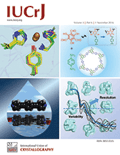
IUCrJ
Pioneering Open Access in Crystallographic ResearchIUCrJ, published by the International Union of Crystallography, is a leading open-access journal dedicated to advancing knowledge in the fields of Biochemistry, Chemistry, Condensed Matter Physics, and Materials Science. Since its inception in 2014, IUCrJ has quickly established itself as a prestigious platform for high-quality research, achieving a remarkable record as a Q1 journal across its categories in 2023. With an increasing impact in the scientific community, evidenced by impressive Scopus rankings, IUCrJ offers unparalleled access to groundbreaking discoveries and methodologies that contribute to the understanding and application of crystallography in various disciplines. The journal’s commitment to open access ensures that research is readily available to a global audience, fostering collaboration and innovation in the scientific community. IUCrJ is an essential resource for researchers, professionals, and students aiming to stay at the forefront of crystallographic research and its interdisciplinary applications.

Acta Crystallographica Section B-Structural Science Crystal Engineering and Materials
Advancing the frontiers of structural science and materials innovation.Acta Crystallographica Section B: Structural Science, Crystal Engineering and Materials, published by the International Union of Crystallography, stands as a pivotal resource for researchers and professionals in the fields of materials science, crystal engineering, and structural biology. With an e-ISSN of 2052-5206, this journal is recognized for its contributions to advancing knowledge on the structural aspects of materials, drawing significant interest from the Q2 category in several disciplines, including Atomic and Molecular Physics and Materials Chemistry. As the field evolves through innovative research approaches and methodologies, the journal actively covers developments within the scope of materials synthesis, characterization, and application in various sectors including medicine and electronics. Though not an open-access journal, it is entangled in the scientific discourse, ensuring that key studies are accessible to academic institutions and professionals globally. With a commitment to excellence, its impact across multiple quartile rankings signifies its influence and importance for scholars eager to contribute to cutting-edge research.

Structural Dynamics-US
Unlocking innovative insights in condensed matter physics.Structural Dynamics-US, published by AIP Publishing, stands as a premier journal within the fields of Condensed Matter Physics, Instrumentation, Radiation, and Spectroscopy. Established in 2014 and operating under an Open Access model, this journal facilitates a broad dissemination of groundbreaking research, enabling researchers and professionals worldwide to contribute to and engage with cutting-edge developments in structural dynamics. With a significant impact highlighted by its Q1 Quartile rankings across multiple categories, and impressive Scopus rankings—including a noteworthy 13th place in Radiation—Structural Dynamics-US provides a vital platform for scholarly communication and innovation in scientific inquiry. The journal's commitment to accessibility and excellence underscores its role as a critical resource for researchers, academics, and students eager to advance their understanding and application of structural dynamics in various scientific contexts.

Korean Journal of Materials Research
Exploring New Horizons in Materials ResearchKorean Journal of Materials Research is a pivotal publication in the field of materials science, offering a platform for innovative research and comprehensive reviews in miscellaneous materials applications. Published by the MATERIALS RESEARCH SOC KOREA, this journal has been a valuable resource since its inception in 2007 and continues to disseminate vital findings through 2024. Although currently categorized in Q4 of the Materials Science quartiles, the journal is committed to advancing knowledge and fostering research collaboration within the scientific community. With an ISSN of 1225-0562 and an E-ISSN of 2287-7258, the journal aims to bridge gaps in research and practice, appealing to a diverse audience of researchers, professionals, and students interested in the latest advancements in materials science. While access to content may not be open, the journal's impact in the regional and global research landscape is steadily growing, as indicated by its Scopus ranking in the 7th percentile of General Materials Science. Engage with the Korean Journal of Materials Research to stay at the forefront of materials innovation!

APPLIED PHYSICS A-MATERIALS SCIENCE & PROCESSING
Transforming Ideas into Materials BreakthroughsApplied Physics A: Materials Science & Processing, published by Springer Heidelberg, is an esteemed academic journal that has been at the forefront of innovative research since its establishment in 1995. With a strong focus on the intersection of physics, materials science, and engineering, this journal explores cutting-edge developments and applications that influence contemporary materials research. Categorized in the Q2 quartile across both Chemistry and Materials Science, it boasts respectable rankings in Scopus, affirming its influence and reach within the academic community. Although primarily a subscription-based journal, it is dedicated to disseminating high-quality research findings that advance our understanding in these fields. Researchers, professionals, and students alike can benefit from the journal's commitment to publishing comprehensive studies, methodological advancements, and insightful reviews that push the boundaries of knowledge in materials science.
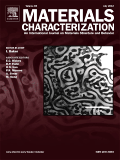
MATERIALS CHARACTERIZATION
Connecting Scholars and Industry for Impactful InsightsMATERIALS CHARACTERIZATION is a leading international journal dedicated to the advancement of knowledge in the field of materials science and engineering. Published by Elsevier Science Inc, this esteemed journal has been disseminating vital research since 1970 and continues to be essential for scholars and industry professionals alike. With an impressive impact reflected in its Q1 quartile rankings across several categories—including Condensed Matter Physics, Materials Science, Mechanical Engineering, and Mechanics of Materials—MATERIALS CHARACTERIZATION stands out as a premier outlet for innovative studies and technical advancements. Researchers can access a wealth of peer-reviewed articles that explore properties, characterization techniques, and applications of materials, fostering interdisciplinary collaboration. With a commitment to high-quality research and comprehensive review processes, the journal plays a crucial role in shaping the future of materials science, making it an invaluable resource for anyone invested in this dynamic field.

POWDER METALLURGY AND METAL CERAMICS
Advancing the Frontiers of Materials SciencePOWDER METALLURGY AND METAL CERAMICS is a prestigious journal published by Springer, dedicated to advancing the field of powder metallurgy and the development of metal ceramics. With an ISSN of 1068-1302 and an E-ISSN of 1573-9066, this journal includes significant research contributions that explore innovative developments in materials science and engineering. Since its inception in 1993, it has garnered attention within multiple disciplines, consistently ranking in the Q2 and Q3 quartiles across categories such as Metals and Alloys, Ceramics and Composites, and Mechanics of Materials. The journal offers valuable insights into the synthesis, characterization, and applications of advanced materials, making it an essential platform for researchers, professionals, and students aiming to stay at the forefront of technological advancements in this dynamic field. Although not currently offering open access, the journal remains a critical resource for disseminating high-quality research that influences both academia and industry.
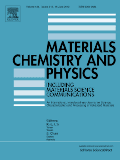
MATERIALS CHEMISTRY AND PHYSICS
Shaping the Future of Materials through Rigorous ResearchMATERIALS CHEMISTRY AND PHYSICS is a leading peer-reviewed journal published by Elsevier Science SA, focusing on the intersection of materials science and condensed matter physics. With an esteemed impact factor and a distinguished reputation in its field, this journal holds a Q1 ranking in Condensed Matter Physics and a Q2 ranking in miscellaneous Materials Science categories as of 2023. Spanning over three decades since its inception in 1983, it provides a vital platform for researchers, professionals, and students to disseminate cutting-edge findings and innovations in materials characterization, properties, and applications. The journal is indexed in Scopus, boasting impressive rankings that reflect its commitment to publishing high-quality research. Although it does not currently offer an Open Access option, it remains an essential resource for those seeking to stay at the forefront of materials chemistry and physics.